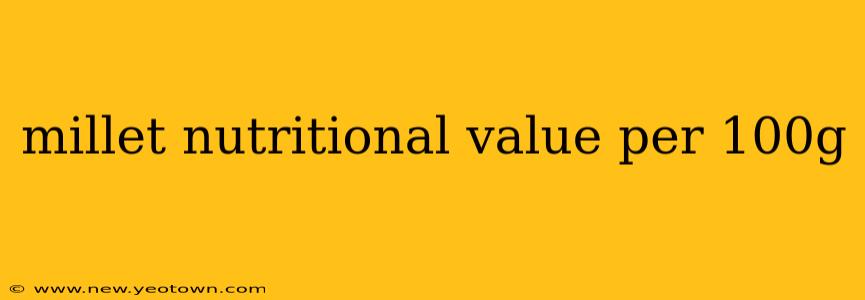Unlocking the Nutritional Powerhouse: A Deep Dive into Millet's 100g Nutritional Profile
Millet, a humble grain often overshadowed by its more popular cousins like rice and wheat, quietly boasts a nutritional profile that’s anything but ordinary. For centuries, it has been a dietary staple across many cultures, and with good reason. Let's delve into the rich nutritional tapestry woven into every 100g serving of this ancient grain.
Imagine a small, unassuming seed, packed with a surprising punch of vitamins, minerals, and fiber. That's millet for you. This comprehensive guide explores the nutritional benefits found within a 100g serving, answering some frequently asked questions along the way.
What are the key nutrients found in 100g of millet?
A 100g serving of cooked millet offers a significant amount of carbohydrates, providing sustained energy throughout the day. However, it's not just about simple carbs. Millet shines with its impressive array of micronutrients. We're talking about essential minerals like magnesium, crucial for muscle and nerve function; phosphorus, supporting bone health; and iron, vital for oxygen transport in the blood. It also offers a good dose of B vitamins, particularly B6, which plays a vital role in brain development and function. Moreover, millet is a decent source of antioxidants, helping to protect cells from damage. The exact amounts vary slightly depending on the type of millet and its preparation method, but the overall nutritional density remains consistently impressive.
How does millet compare nutritionally to other grains?
Compared to refined grains like white rice, millet stands out as a nutritional champion. Its higher fiber content contributes to improved digestion and satiety, keeping you feeling full for longer. Unlike many refined grains, millet retains its bran and germ, making it a rich source of vital nutrients often lost during processing. While it might not boast the protein levels of quinoa, it still provides a respectable amount, making it a valuable addition to a balanced diet.
Is millet gluten-free?
Yes, millet is naturally gluten-free, making it a safe and nutritious option for individuals with celiac disease or gluten sensitivities. This is a significant advantage over wheat, barley, and rye, which contain gluten. This characteristic has propelled millet's popularity among those seeking gluten-free alternatives.
What are the health benefits of consuming millet?
The nutritional richness of millet translates to numerous potential health benefits. Its high fiber content promotes healthy digestion and can help prevent constipation. The magnesium content can contribute to better blood sugar control, while the iron aids in preventing anemia. The antioxidants help protect against cellular damage, potentially reducing the risk of chronic diseases. Furthermore, the relatively low glycemic index of millet means it releases sugar into the bloodstream gradually, preventing sharp spikes and promoting stable energy levels.
How can I incorporate millet into my diet?
Millet's versatility makes it incredibly easy to integrate into your diet. It can be cooked like rice, used as a flour in baking, or even popped like popcorn! Think millet porridge for breakfast, millet salads for lunch, or millet-based side dishes for dinner. The possibilities are truly endless. Experiment with different recipes and discover your favorite ways to enjoy this nutritional powerhouse.
Conclusion:
Millet is more than just a grain; it's a nutritional goldmine. Its impressive nutrient profile, gluten-free nature, and versatility make it a valuable addition to any healthy diet. So, next time you're looking for a nutritious and delicious grain, remember the humble millet and unlock its remarkable nutritional benefits.

